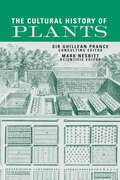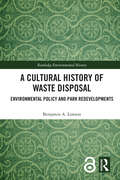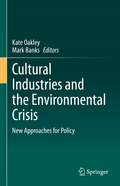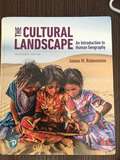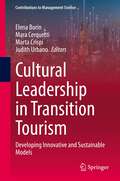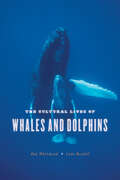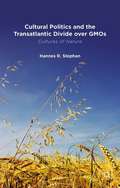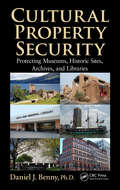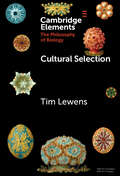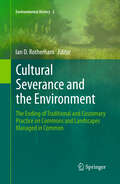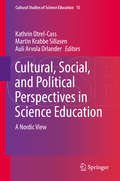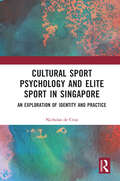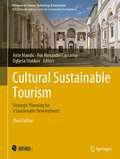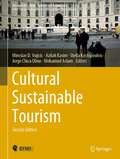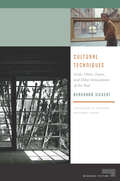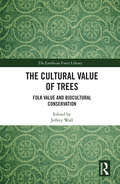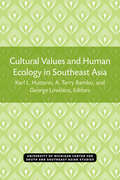- Table View
- List View
A Cultural History of Heredity
by Staffan Muller-Wille Hans-Jorg RheinbergerIt was only around 1800 that heredity began to enter debates among physicians, breeders, and naturalists. Soon thereafter it evolved into one of the most fundamental concepts of biology. Here Staffan Müller-Wille and Hans-Jörg Rheinberger offer a succinct cultural history of the scientific concept of heredity. They outline the dramatic changes the idea has undergone since the early modern period and describe the political and technological developments that brought about these changes. Müller-Wille and Rheinberger begin with an account of premodern theories of generation, showing that these were concerned with the procreation of individuals rather than with hereditary transmission. The authors reveal that when hereditarian thinking first emerged, it did so in a variety of cultural domains, such as politics and law, medicine, natural history, breeding, and anthropology. Müller-Wille and Rheinberger then track theories of heredity from the late nineteenth century—when leading biologists considered it in light of growing societal concerns with race and eugenics—through the rise of classical and molecular genetics in the twentieth century, to today, as researchers apply sophisticated information technologies to understand heredity. What readers come to see from this exquisite history is why it took such a long time for heredity to become a prominent concept in the life sciences and why it gained such overwhelming importance in those sciences and the broader culture over the last two centuries.
A Cultural History of Heredity
by Staffan Müller-Wille Hans-Jörg Rheinberger&“Thought-provoking…any scientist interested in genetics will find this an enlightening look at the history of this field.&”—Quarterly Review of Biology It was only around 1800 that heredity began to enter debates among physicians, breeders, and naturalists. Soon thereafter, it evolved into one of the most fundamental concepts of biology. Here, Staffan Muller-Wille and Hans-Jorg Rheinberger offer a succinct cultural history of the scientific concept of heredity. They outline the dramatic changes the idea has undergone since the early modern period and describe the political and technological developments that brought about these changes. They begin with an account of premodern theories of generation, showing that these were concerned with the procreation of individuals rather than with hereditary transmission, and reveal that when hereditarian thinking first emerged, it did so in a variety of cultural domains, such as politics and law, medicine, natural history, breeding, and anthropology. The authors then track theories of heredity from the late nineteenth century—when leading biologists considered it in light of growing societal concerns with race and eugenics—through the rise of classical and molecular genetics in the twentieth century, to today, as researchers apply sophisticated information technologies to understand heredity. What we come to see from this exquisite history is why it took such a long time for heredity to become a prominent concept in the life sciences, and why it gained such overwhelming importance in those sciences and the broader culture over the last two centuries.
A Cultural History of Physics
by Károly SimonyiWhile the physical sciences are a continuously evolving source of technology and of understanding about our world, they have become so specialized and rely on so much prerequisite knowledge that for many people today the divide between the sciences and the humanities seems even greater than it was when C. P. Snow delivered his famous 1959 lecture, "The Two Cultures." In A Cultural History of Physics, Hungarian scientist and educator Károly Simonyi succeeds in bridging this chasm by describing the experimental methods and theoretical interpretations that created scientific knowledge, from ancient times to the present day, within the cultural environment in which it was formed. Unlike any other work of its kind, Simonyi’s seminal opus explores the interplay of science and the humanities to convey the wonder and excitement of scientific development throughout the ages. These pages contain an abundance of excerpts from original resources, a wide array of clear and straightforward explanations, and an astonishing wealth of insight, revealing the historical progress of science and inviting readers into a dialogue with the great scientific minds that shaped our current understanding of physics. Beautifully illustrated, accurate in its scientific content and broad in its historical and cultural perspective, this book will be a valuable reference for scholars and an inspiration to aspiring scientists and humanists who believe that science is an integral part of our culture.
The Cultural History of Plants
by Mark Nesbitt Ghillean PranceThis valuable reference will be useful for both scholars and general readers. It is both botanical and cultural, describing the role of plant in social life, regional customs, the arts, natural and covers all aspects of plant cultivation and migration and covers all aspects of plant cultivation and migration. The text includes an explanation of plant names and a list of general references on the history of useful plants.
A Cultural History of Waste Disposal: Environmental Policy and Park Redevelopments (Routledge Environmental History)
by Benjamin A. LawsonThis book offers a historical analysis of landfill sites in New York City, Greater Toronto, and Greater Tel Aviv, and uses them as case studies to emphasize the international and global scale of issues concerning waste disposal and park redevelopments.New York, Toronto, and Tel Aviv are currently redeveloping giant landfills into parks to much fanfare. The park redevelopments may be seen as an attempt to erase or assuage the decades of problematic waste-disposal policy that led to the creation of such large landfills. Booster rhetoric underscores this point, such as promoting how the parks will be a “green lung” for the city. This book contextualizes these redevelopments by offering a historical analysis, providing a greater understanding of the past, current, and future potential issues. It goes on to analyze the language and media coverage surrounding former waste sites becoming park redevelopments, including how cities use art to promote their image and gain cultural relevance. By engaging with both the works of waste historians and literature on waste and discard studies, the book provides theoretical models for analyzing the role of power in municipal systems, as well as human and ecological impacts on waste. It concludes with an analysis of the features necessary for landfill parks to be successful. This book will be useful for scholars, researchers, and academics studying waste studies, the environment, cities, and sustainable development, as well as for policymakers and environmental/eco artists.
Cultural Industries and the Environmental Crisis: New Approaches for Policy
by Kate Oakley Mark BanksThis volume critiques the current model of the creative economy, and considers alternative models that may point to greener, cleaner, more sustainable and socially just cultural and creative industries. Aimed at the nexus of cultural and environmental concerns, the book assesses the ways in which arts and cultural activities can help develop ideas of the ‘good life’ beyond excessive and unsustainable material consumption, and explores the complex interactions between cultural prosperity, place and the quality (and availability) of employment, leisure and the rights to self-expression. Adopting a deliberately wide and inclusive interdisciplinary and international perspective, contributors to this volume showcase current and future ways of ‘doing’ creative economy, ecologically, otherwise and differently. In 11 chapters, the book outlines some of the most relevant arguments from among the growing literature that critically analyzes the current creative economy, with a focus on issues of gentrification, inequality and environment. This volume is timely, as it emerges into a political and economic context that is seeking desperately to ‘reboot’ the economy, re-establish ‘business as usual’ and to do so partly through significant investment and expansion in the creative economy. The book will be suitable for upper level undergraduates and postgraduates studying a wide range of topics, including: cultural and creative industries, media and communications, cultural studies, cultural policy, human geography, environmental humanities and environmental policy, and will be of further interest to arts professionals, creative economy researchers and policymakers. The chapter “Towards a New Paradigm of the Creative City or the Same Devil in Disguise? Culture-led Urban (Re)development and Sustainability” is available open access under a Creative Commons Attribution 4.0 International License via link.springer.com.
Cultural Initiatives for Sustainable Development: Management, Participation and Entrepreneurship in the Cultural and Creative Sector (Contributions to Management Science)
by Giovanni Schiuma Lucia Marchegiani Paola Demartini Michela MarchioriThis book explores the relevance of new sources, dimensions, and characteristics of knowledge for supporting creative and cultural organizations and initiatives.Special emphasis is placed on cultural heritage, participatory approaches, and entrepreneurship in the cultural and creative sector. The role of cultural heritage and contemporary culture as a source of economically effective, socially sustainable development is also discussed. The authors examine new ways of developing and testing new and innovative models of management for cultural heritage assets. In line with the participatory approaches in culture heritage governance promoted by the EU, the authors analyze participatory approaches to cultural and creative initiatives. The role of public and private actors, as well as the way they interact with each other in order to achieve collective outcomes, is of particular interest in this section of the book. With regard to cultural and creative entrepreneurship, the book adds an innovative view of cultural ventures, offering some clues from an entrepreneurial ecosystem perspective.
The Cultural Landscape: An Introduction to Human Geography
by Rubenstein James M.The Cultural Landscape: An Introduction to Human Geography uses a structured learning path to look into the patterns and processes of Earth's human landscapes. Rubenstein explores the relationships between people and their locations, looking at where people and activities are located across Earth's surface and understanding why they are located in particular places.
Cultural Leadership in Transition Tourism: Developing Innovative and Sustainable Models (Contributions to Management Science)
by Elena Borin Mara Cerquetti Marta Crispí Judith UrbanoCultural tourism has proved to be a significant source of economic development for cultural destinations, but it has also emerged as a sometimes potentially controversial and unsustainable phenomenon. The recent pandemic has also pointed out that we need different models of development of tourism, that include a more balanced approach to cultural components in cities and rural areas. Calls have been made on the need to design more sustainable models of tourism development for cultural destinations, conceiving tourism as a means to increasing the quality of life and generating economic opportunities in cities and regions by involving their communities and stakeholders. This book presents an in-depth analysis of the transition towards more sustainable models of cultural tourism development. Starting from the ongoing debate on cultural ecosystems, the book explores the potential key role of cultural and creative organizations as leaders of change. Including theoretical contributions, quantitative and qualitative analyses and international case studies, the book explores the role of cultural actors as leaders and their potential as drivers of culture-led innovation for tourism in cities and regions.
The Cultural Lives of Whales and Dolphins
by Hal Whitehead Luke RendellIn the songs and bubble feeding of humpback whales; in young killer whales learning to knock a seal from an ice floe in the same way their mother does; and in the use of sea sponges by the dolphins of Shark Bay, Australia, to protect their beaks while foraging for fish, we find clear examples of the transmission of information among cetaceans. Just as human cultures pass on languages and turns of phrase, tastes in food (and in how it is acquired), and modes of dress, could whales and dolphins have developed a culture of their very own? Unequivocally: yes. In The Cultural Lives of Whales and Dolphins, cetacean biologists Hal Whitehead, who has spent much of his life on the ocean trying to understand whales, and Luke Rendell, whose research focuses on the evolution of social learning, open an astounding porthole onto the fascinating culture beneath the waves. As Whitehead and Rendell show, cetacean culture and its transmission are shaped by a blend of adaptations, innate sociality, and the unique environment in which whales and dolphins live: a watery world in which a hundred-and-fifty-ton blue whale can move with utter grace, and where the vertical expanse is as vital, and almost as vast, as the horizontal. Drawing on their own research as well as a scientific literature as immense as the sea--including evolutionary biology, animal behavior, ecology, anthropology, psychology, and neuroscience--Whitehead and Rendell dive into realms both humbling and enlightening as they seek to define what cetacean culture is, why it exists, and what it means for the future of whales and dolphins. And, ultimately, what it means for our future, as well.
Cultural Materialism: The Struggle for a Science of Culture
by Marvin HarrisFirst published in 1968, Harris's book has been cited in over 1,000 works and is one of the key documents explaining cultural materialism, the theory associated with Harris's work. This updated edition includes the complete 1968 text plus a new introduction by the author, which discusses the impact of the book and highlights some of the major trends in anthropological theory since its original publication. RAT, as it is affectionately known to three decades of graduate students, comprehensively traces the history of anthropology and anthropological theory, culminating in a strong argument for the use of a scientific, behaviorally-based, ethic approach to the understanding of human culture known as cultural materialism
The Cultural Origins of Human Cognition
by Michael TomaselloAmbitious and elegant, this book builds a bridge between evolutionary theory and cultural psychology. Michael Tomasello is one of the very few people to have done systematic research on the cognitive capacities of both nonhuman primates and human children. The Cultural Origins of Human Cognition identifies what the differences are, and suggests where they might have come from. Tomasello argues that the roots of the human capacity for symbol-based culture, and the kind of psychological development that takes place within it, are based in a cluster of uniquely human cognitive capacities that emerge early in human ontogeny. These include capacities for sharing attention with other persons; for understanding that others have intentions of their own; and for imitating, not just what someone else does, but what someone else has intended to do. In his discussions of language, symbolic representation, and cognitive development, Tomasello describes with authority and ingenuity the "ratchet effect" of these capacities working over evolutionary and historical time to create the kind of cultural artifacts and settings within which each new generation of children develops. He also proposes a novel hypothesis, based on processes of social cognition and cultural evolution, about what makes the cognitive representations of humans different from those of other primates. Lucid, erudite, and passionate, The Cultural Origins of Human Cognition will be essential reading for developmental psychology, animal behavior, and cultural psychology.
Cultural Politics and the Transatlantic Divide over GMOs
by Hannes R. StephanAlongside other factors, cultural values and identities help to explain different regulatory frameworks for genetically modified organisms. This book uses insights from environmental history and sociology to illuminate the cultural politics of regulation in the US and the EU, with particular attention to public opinion and anti-GMO activism.
Cultural Property Security: Protecting Museums, Historic Sites, Archives, and Libraries
by Daniel J. BennyThe protection and security of cultural properties is of primary concern to the thousands of federal, state, county, city, and private institutions entrusted with housing and displaying our national heritage and history of our society. Cultural property security is of global importance as well, with tens of thousands of institutions internationally
Cultural Selection (Elements in the Philosophy of Biology)
by Tim LewensHumans learn in ways that are influenced by others. As a result, cultural items of many types are elaborated over time in ways that build on the achievements of previous generations. Culture therefore shows a pattern of descent with modification reminiscent of Darwinian evolution. This raises the question of whether cultural selection-a mechanism akin to natural selection, albeit working when learned items are passed from demonstrators to observers-can explain how various practices are refined over time. This Element argues that cultural selection is not necessary for the explanation of cultural adaptation; it shows how to build hybrid explanations that draw on aspects of cultural selection and cultural attraction theory; it shows how cultural reproduction makes problems for highly formalised approaches to cultural selection; and it uses a case-study to demonstrate the importance of human agency for cumulative cultural adaptation.
Cultural Severance and the Environment: The Ending of Traditional and Customary Practice on Commons and Landscapes Managed in Common (Environmental History #2)
by Ian D. RotherhamThis major book explores commons, lands and rights of usage in common, traditional and customary practices, and the cultural nature of 'landscapes'. Importantly, it addresses now critical matters of 'cultural severance' and largely unrecognized impacts on biodiversity and human societies, and implications for conservation, sustainability, and local economies. The book takes major case studies and perspectives from around the world, to address contemporary issues and challenges from historical and ecological perspectives. The book developed from major international conferences and collaborations over around fifteen years, culminating 'The End of Tradition?' in Sheffield, UK, 2010. The chapters are from individuals who are both academic researchers and practitioners. These ideas are now influencing bodies like the EU, UNESCO, and FAO, with recognition by major organisations and stakeholders, of the critical state of the environment consequent on cultural severance.
Cultural, Social, and Political Perspectives in Science Education: A Nordic View (Cultural Studies of Science Education #15)
by Kathrin Otrel-Cass Martin Krabbe Sillasen Auli Arvola OrlanderThis book presents a collection of critical thinking that concern cultural, social and political issues for science education in the Nordic countries. The chapter authors describe specific scenarios to challenge persisting views, interrogate frameworks and trouble contemporary approaches to researching teaching and learning in science. Taking a point of departure in empirical examples from the Nordic countries the collection of work is taking a critical sideways glance at the Nordic education principles. Critical examinations target specifically those who are researching in the fields of science education research to question whether conventional research approaches, foci and theoretical approaches are sufficient in a world of science education that is neither politically neutral, nor free of cultural values. Attention is not only on the individual learner but on the cultural, social and political conditions and contexts in science education. The different chapters review debates and research in teacher education, school teaching and learning including when external stakeholders are involved. Even though the chapters are contextualized in Nordic settings there will be similarities and parallels that will be informative to the international science education research community.
Cultural Sport Psychology and Elite Sport in Singapore: An Exploration of Identity and Practice
by Nicholas de CruzGuided by the principles of cultural sport psychology (CSP), this book explores the psychosocial issues surrounding elite sport and psychological practice in Singapore. CSP recognises the importance of understanding people as individuals, rather than objectifying and interpreting psychological processes independent of the socio-cultural context in which they stem from. For sport psychology to progress, it is imperative to distinguish and appreciate the difference between treating someone the same (i.e., culturally blind approach) and treating them equally (i.e., possess cultural awareness). To address the paucity of cultural-specific research, this book explores the psychosocial issues of elite sport in Singapore using CSP as a theoretical and guiding philosophy. Given Singapore’s recent successes at the Olympic and Paralympic levels, this book is ideally timed to investigate the social and cultural developments of elite sport as they occur in a specific sociocultural context. The authors argue that if elite sport and sport psychology is to progress in Singapore, there is a need to refine its elite ecosystem, regulate the practice of sport psychology, and work towards establishing a professional community centred around a culture of constructive exchange, debate and cooperation. This book presents a blueprint to any researcher, national institute, or practitioner, to systematically explore the culture and context within which they operate and organise action plans to address unique needs that were identified through this process.
Cultural Studies and Environmentalism: The Confluence of EcoJustice, Place-based (Science) Education, and Indigenous Knowledge Systems (Cultural Studies of Science Education #3)
by Michiel Van Eijck Jennifer D Adams Michael P. Mueller Deborah J. TippinsAs the first book to explore the confluence of three emerging yet critical fields of study, this work sets an exacting standard. The editors' aim was to produce the most authoritative guide for ecojustice, place-based education, and indigenous knowledge in education. Aimed at a wide audience that includes, but is not restricted to, science educators and policymakers, Cultural Studies and Environmentalism starts from the premise that schooling is a small part of the larger educational domain in which we live and learn. Informed by this overarching notion, the book opens up ways in which home-grown talents, narratives, and knowledge can be developed, and eco-region awareness and global relationships can be facilitated. Incorporating a diversity of perspectives that include photography, poetry and visual art, the work provides a nuanced lens for evaluating educational problems and community conditions while protecting and conserving the most threatened and vulnerable narratives. Editors and contributors share the view that the impending loss of these narratives should be discussed much more widely than is currently the case, and that both teachers and children can take on some of the responsibility for their preservation. The relevance of ecojustice to this process is clear. Ecojustice philosophy is a way of learning about how we frame, or perceive, the world around us--and why that matters. Although it is not synonymous with social or environmental justice, the priorities of ecojustice span the globe in the same way. It incorporates a deep recognition of the appropriateness and significance of learning from place-based experiences and indigenous knowledge systems rather than depending on some urgent "ecological crises" to advocate for school and societal change. With a multiplicity of diverse voices coming together to explore its key themes, this book is an important starting point for educators in many arenas. It brings into better focus a vital role for the Earth's ecosystems in the context of ecosociocultural theory and participatory democracy alike. "Encompassing theoretical, empirical, and experiential standpoints concerning place-based knowledge systems, this unique book argues for a transformation of (science) education's intellectual tradition of thinking that emphasizes individual cognition. In its place, the book offers a wisdom tradition of thinking, living, and being that emphasizes community survival in harmony within itself and with Mother Earth." Glen Aikenhead
Cultural Sustainable Tourism: Strategic Planning for a Sustainable Development (Advances in Science, Technology & Innovation)
by Ante Mandić Rui Alexandre Castanho Uglješa StankovThis book discusses the the integration between tourism and heritage and strategies to achieve sustainability in the tourism sector. The book adds innovative insights into the development of new practices solving challenges of sustainability in this sector and promoting responsible tourism. The book in hands also offers solutions and discusses sustainable tourism environment, social and economic impacts of tourism, and policies and mechanisms for heritage preservation. The primary audience of this book will be scholars, planners, architects, and stakeholders interested in sustainable tourism. This book is a culmination of selected research papers from IEREK’s third edition of the International Conference on Cultural Sustainable Tourism (CST) held online in collaboration with the University of Maya, Portugal (2021).
Cultural Sustainable Tourism (Advances in Science, Technology & Innovation)
by Miroslav D. Vujicic Azilah Kasim Stella Kostopoulou Jorge Chica Olmo Mohamed AslamThis book is an assemblage of diverse yet homogenous research papers that bring together the issues and challenges of cultural heritage conservation and tourism sustainability. The richness of this book stems from its inclusion of diverse case studies from around the globe while scrutinizing the cases of both deterioration and sustainability of cultural heritage belonging to different eras.This book sheds light on the connections between culture as an essential dimension of local sustainability and cultural dimensions of sustainable tourism, further contributing to the complex discussion between culture and tourism. This book gives an overview of current research and subjects of discussion that focuses on cultural sustainable tourism through several sections, such as planning and management of sustainable tourism, sustainable cultural tourism development in a digital era, social and economic impacts of cultural tourism, and sustainable tourism development in urban areas
Cultural Techniques: Grids, Filters, Doors, and Other Articulations of the Real (Meaning Systems)
by Bernhard SiegertIn a crucial shift within posthumanistic media studies, Bernhard Siegert dissolves the concept of media into a network of operations that reproduce, displace, process, and reflect the distinctions fundamental for a given culture. Cultural Techniques aims to forget our traditional understanding of media so as to redefine the concept through something more fundamental than the empiricist study of a medium’s individual or collective uses or of its cultural semantics or aesthetics. Rather, Siegert seeks to relocate media and culture on a level where the distinctions between object and performance, matter and form, human and nonhuman, sign and channel, the symbolic and the real are still in the process of becoming. The result is to turn ontology into a domain of all that is meant in German by the word Kultur.Cultural techniques comprise not only self-referential symbolic practices like reading, writing, counting, or image-making. The analysis of artifacts as cultural techniques emphasizes their ontological status as “in-betweens,” shifting from firstorder to second-order techniques, from the technical to the artistic, from object to sign, from the natural to the cultural, from the operational to the representational.Cultural Techniques ranges from seafaring, drafting, and eating to the production of the sign-signaldistinction in old and new media, to the reproduction of anthropological difference, to the study of trompe-l’oeils, grids, registers, and doors. Throughout, Siegert addresses fundamental questions of how ontological distinctions can be replaced by chains of operations that process those alleged ontological distinctions within the ontic.Grounding posthumanist theory both historically and technically, this book opens up a crucial dialogue between new German media theory and American postcybernetic discourses.
Cultural Tourism in the Asia Pacific: Heritage, City and Rural Hospitality
by Tai-Chee Wong Hoon-Peow See Meg MilliganThis book covers multiple cultural tourism aspects including among others, nature and rural conservation policy and conflicts, reflected in case studies, and ethnic minority heritage and their folklore traditions and performances, as well as tourism activities in the city areas. It provides a distinguished quality and an innovative focus to the existing literature by highlighting the unique features and development experience in cultural tourism in the Asia Pacific in both the rural and urban setting. The book has a strong appeal to an international audience, including both tertiary institution academics and students, seeking a better understanding of public policy and cultural tourism practices in the contemporary world.
The Cultural Value of Trees: Folk Value and Biocultural Conservation (The Earthscan Forest Library)
by Jeffrey WallThis volume focuses on the tree, as a cultural and biological form, and examines the concept of folk value and its implications for biocultural conservation. Folk value refers to the value of the more-than-human living world to cultural cohesion and survival, as opposed to individual well-being. This field of value, comprising cosmological, aesthetic, eco-erotic, sentimental, mnemonic value and much more, serves as powerful motivation for the local performance of environmental care. The motivation to maintain and conserve ecology for the purpose of cultural survival will be the central focus of this book, as the conditions of the Anthropocene urgently require the identification, understanding and support of enduring, self-perpetuating biocultural associations. The geographical scope is broad with chapters discussing different tree species from the Americas and the Caribbean, East Asia, Eurasia and Australia and Africa. By focusing on the tree, one of the most reliably cross-culturally-valued and cross-culturally-recognized biological forms, and one which invariably defines expansive landscapes, this work illuminates how folk value binds the survival of more-than-human life forms with the survival of specific peoples in the era of biocultural loss, the Anthropocene. As such, this collection of cross-cultural cases of tree folk value represents a low hanging fruit for the larger project of exploring the power of cultural value of the more-than-human living world. This book will be of great interest to students and scholars of conservation, biodiversity, biocultural studies and environmental anthropology.
Cultural Values and Human Ecology in Southeast Asia (Michigan Papers On South And Southeast Asia #27)
by Karl L. Hutterer A. Terry Rambo George LovelaceCultural Values and Human Ecology in Southeast Asia


